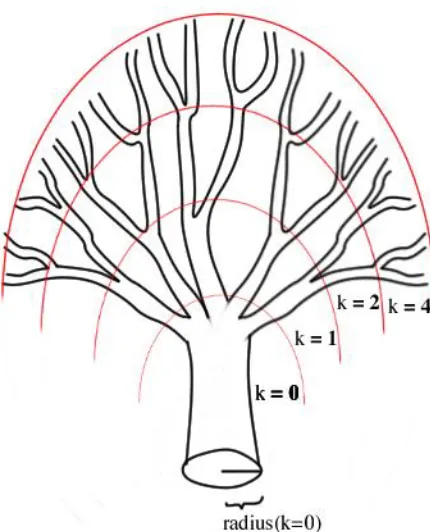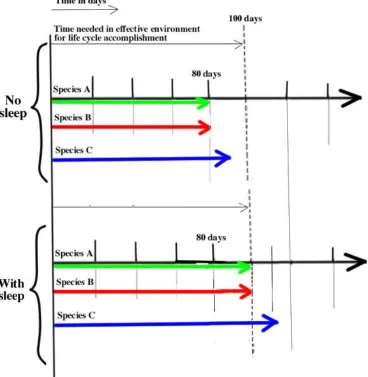Sleep Optimizes Time in the Effective Environment
Niloufar J Ataie
niloufar.ataie@faculty.umgc.edu nilouataie@gmail.com
808-927-6358
Why animals sleep is an outstanding open question. Information about the toxic byproducts of aerobic cellular respiration along with the analysis of patterns in animal size, sleep needs, dietary-type, metabolism, number of heart beats, transportation-network design, and transportation energetics/dynamics suggest that the function of sleep is to maximize the time an animal has to perform its life functions given the finite and constant number of lifetime heart beats it has. Sleep slows down metabolism, and the heart rate, thereby decreasing the load of toxic reactive oxygen species in the cell and extending the cell’s lifetime/proper-functioning. I argue that this is used to maximize the time an animal spends in its ‘effective environment’, which is defined as the period in the light cycle (day or night) where the essential life-functions of that animal (like finding resources, finding sex, hunting) are better achieved. Larger, slow-metabolizing animals need less sleep because their large-bodily-networks and slow metabolisms keep their heart rates relatively low, resulting in a lower rate of oxidative damage, and more relative time in the ‘effective environment’ to get their essential life-functions accomplished.
Keywords: sleep; allometric scaling; oxidative stress
The Patterns of Sleep
Studies of sleep requirements of different kinds of animals have shown some interesting patterns. Studies and observations show distinct size vs. sleep time patterns depending on the dietary needs of the animal (reviewed in 7). When animals are categorized as carnivores, omnivores, or herbivores there is an overall general pattern where sleep is inversely correlated with body mass: the larger the animal’s body, the less sleep that animal needs. This effect is greatest amongst the herbivores and smallest within the carnivores. Carnivores also have the highest basal metabolic rates and the highest sleep requirements, all else being equal (8). An explanation for this observation is that the kinds of muscles fibers that carnivores have are designed for endurance and require higher oxygen consumption (8). Unlike the mild size effects seen with carnivores, herbivores’ need for sleep drops off steeply the larger they get. But the general trend across all categories is that size tracks inversely with sleep needs.
The Good and Bad of the O2 Molecule
During aerobic cellular respiration, the body uses the energy stored in the oxygen molecule (O2)
to make ATP and waste products. The weak -bonding of the O2 molecule gives it a very
high-energy value of combustion (9,10), making it a good molecule to exploit for free energy capture
and utilization, and almost all animals use the O2 molecule during aerobic respiration. During
cellular respiration, the energy transferred from the O2 molecule to ATP is used to power the
formation, repair, and growth of bodies and life processes.
The vital and life sustaining energy-rich-molecules that aerobic respiration provides via the
combustion of the O2 molecule come with a great price- highly reactive and destructive oxygen
species byproducts. The reactive oxygen species (ROS) of O2 respiration include free radicals like •O−
2 (superoxide radical) and •OH (hydroxyl radical); and also, molecules like H2 O2 (22) Figure
1.
O2 + e
−→
•O
−22 H
++
•O
−2 + •O
−2 → H2O2 + O2H2O2 + e
−→ HO
−+
•OH
Figure 1: Aerobic cellular respiration utilizes the energy rich O2 molecule which produces toxic, reactive
oxygen species (ROS). The reduction of molecular oxygen (O2) produces superoxide, •O−2, and that can
produce hydrogen peroxide, H2O2, which may in turn
form the reactive hydroxide ion and hydroxyl radical
•OH (22). Many of these reactive species can wreak
Even with proper housekeeping systems in place, the body struggles to clear itself of these costly byproducts and ROS produced by cellular respiration have been implicated in the destruction of macromolecules and signaling pathways. Studies show that reactive oxygen species cause DNA base damage and breaks (11) and lipid and protein damage (12,13,14). Reactive oxygen species have also been shown to interfere with cellar pathways and signaling (15). The cell’s ability to reliably undergo its cellular functions and undergo accurate cell division depend on the integrity of the DNA instructions within the cell and macromolecular machinery running the processes. Oxidative stress, over time, can degrade the information and machinery that a cell needs to function, resulting in cell death and/or cell-malfunctioning.
Allometric Laws and Efficient Transportation Design
Studies show that in general larger animals live longer than smaller animals by a scaling factor of approximately 25% (16,17). Though larger animals live longer than smaller ones, the total number of heart beats across mammals is a constant-average-number of almost 1 billion (18).
The way that an animal attribute is related to its mass can be presented by the scaling equation, equation 1:
Where Y = variable (like network tube dimension, metabolic rate, etc.); M is the mass of the organism; Y = constant; and b = the scaling exponent. Empirical observations show that many
aspects of the mammalian system scale with a ¼ or ¾ scaling exponent (19). Some of these attributes include the network’s tube dimensions, metabolic rates, circulation times, circulation distances, O2 consumption rates, respiratory frequency, and number of capillaries.
The restraints imposed by physics and biology, and the minimization of energy and the maximization of service area, shape and design the transportation networks that organisms use to
deliver supplies (like O2) throughout their bodies (19). The observed quarter-power scaling laws
seen in many biological systems has been proposed to be a consequence of network-design-optimization where optimal supply of goods within the volume is maximized by branching-networks of surface-area-enhancing-tubes utilizing the fractal dimension (19-21). This model assumes that the final branches (capillaries for the cardiovascular system) are uniform across animals (which is supported by observation), and that the system is optimized toward efficient transportation and routing. Figure 2 shows the structure of the space-filling fractal design that many biological distribution networks follow.
Sleep Increase Time in the Light (or the dark).
Animals have a lifetime constant-average-number of approximately 1 billion heart beats. Each of those heart beats brings to each of the animal’s cells highly combustible O2 molecules that not
only bring riches of energy but also destructive toxic waste. With each circulation, the O2 molecule
is transported through optimized fractal-like networks to the cells of the body where it helps create important molecules needed to build and sustain bodies. The rate of delivery of the O2 molecule
depends on the size of the animal and its metabolism. Larger animals have a larger effective volume to service and their heart rates are slower than their smaller animal counterparts. Animals with greater oxygen needs like carnivores, have higher basal resting metabolisms and their heart rates tend to be greater than their herbivore animal counterparts. Studies show that in general larger animals live longer than smaller animals by a scaling factor of approximately 25% (16,17).
These data put together suggest that the function of sleep is to maximize the time an animal has to perform its life functions given the finite and constant number of lifetime heart beats that every animal has. Sleep slows down metabolism, and the heart rate, thereby decreasing the load of toxic reactive oxygen species in the cell and extending the cell’s lifetime and proper-functioning. This is used to maximize the time an animal spends in its ‘effective environment’, which is defined as the period in the light cycle (day or night) where the essential life-functions of that animal are better achieved. For example, most animals would benefit from sunlight in the search for food and sex partners, so their effective environment would be the daytime. For these kinds of animals, the light provided by the sun allows them to better achieve life-sustaining goals and avoid life terminating obstacles. Daylight enhances the animal’s ability to locate predators and prey and find and examine food sources and sexual partners. Without light, for many animals, these endeavors would prove futile and/or dangerous.
In Figure 3, I describe a hypothetical situation that shows the effect that sleep has on this model. In this example, Species A, B, and C represent three kinds of species that all require at least 100 days in their effective environments to accomplish their necessary bodily functions to live and reproduce. Species A is small and slow metabolizing; Species B is larger, but carnivorous and faster metabolizing; and Species C is the same size as Species B, but an herbivore so it metabolizes slower. All three species have an average constant heart beat number of 1 billion or 10X10^8.
References:
1.) Kripke DF, Simons RN, Garfinkel L, and EC Hammond. Short and long sleep and sleeping pills. Is increased mortality associated? Arch Gen Psychiatry. 1979;Vol 36:103- 116.
2.) Wingard DB and LF Berkman. Mortality risk associated with sleeping patterns among adults. Sleep. 1983;Vol 6:102- 107.
3.) Spiegel K, Leproult R, and E Van Cauter. Impact of sleep debt on metabolic and endocrine function. Lancet. 1999;Vol354:1435- 1439.
4.) Tochibuko O, Ikeda A, Miyajima E, and M Ishii. Effects of insufficient sleep on blood pressure monitored by a new multibiomedical recorder. Hypertension. 1996;Vol 27:1318- 1324.
5.) Kripke DF, Garfinkel L, Wingard DL, Klauber MR, and MR Marler. Mortality associated
with sleep duration and insomnia. Archives in General Psychiatry. 2002;Vol 59(2):131–
136.
6.) Sleep Disorders and Sleep Deprivation: An Unmet Public Health Problem. Institute of Medicine (US) Committee on Sleep Medicine and Research; Colten HR, Altevogt BM, editors. Washington (DC): National Academies Press (US); 2006.
7.) JM Siegel. Clues to the functions of mammalian sleep. Nature. 2005;Vol 437:1264-1271.
8.) Munoz-Garcia A and JB Williams. Basal metabolic rate in carnivores is associated with diet after controlling for phylogeny. Physiological and Biochemical Zoology 2005;78(6):000-000. The University of Chicago.
9.) K Schmidt-Rohr. Oxygen is the High-Energy Molecule Powering Complex Multicelluar Life: Fundamental Corrections to Traditional Bioenergetics. ACS Omega. 2020;Vol 5, 2221-2233.
10.) K Schmidt-Rohr. Why Combustions are Always Exothermic. J.Chem Educ. 2015;Vol 92: 2094-2099.
11.) HC Birnboim. DNA strand breaks in human leukocytes induced by superoxide anion, hydrogen peroxide and tumor promoters are repaired slowly compared to breaks induced by ionizing radiation. Carcinogenesis. 1986;Vol 7, 1511-1517.
13.) H Yin, and NA Porter. New insights regarding the autoxidation of polyunsaturated fatty acids. Antioxid. Redox Signaling. 2005;Vol 7:170–184.
14.) Poon HF, Calabrese V, Scapagnini G and DA Butterfield. Free radicals: key to brain aging and heme oxygenase as a cellular response to oxidative stress. J. Gerontol Ser. A. 2004;Vol 59:478–493.
15.) Riahi Y, Cohen G, Ofer S, and S Sasson. Signaling and cytotoxic functions of 4-hydroxyalkenals. Am J Physiol Endocrinol Metab. 2010;299:E879-E866.
16.) Speakman J. R. Body size, energy metabolism and lifespan. J. Exp. Biol. 2005;Vol 208: 1717–1730.
17.) Hulbert AJ, Pamplona R., Buffenstein R, and WA Buttemer. Life and Death: Metabolic rate, membrane composition, and life span of animals. Physiol Rev. 2007;Vol 87:1175– 1213.
18.) HJ Levine. Rest Heart Rate and Life Expectancy. JACC. 1997;Vol 30:1104-1106.
19.) West GB, Brown JH, and BJ Enquist. A General Model for the Origin of Allometric Scaling Laws in Biology. Science. 1997;Vol 276:122-126.
20.) West GB, and JH Brown. The origin of allometric scaling laws in biology from genomes to ecosystems: towards a quantitative unifying theory of biological structure and organization. The Journal of Experimental Biology. 2005;Vol 208:1575-1592.
21.) BB Mandelbrot Fractals: Form, Chance, and Dimension. San Francisco. W. H. Freeman and Company. 1977.

